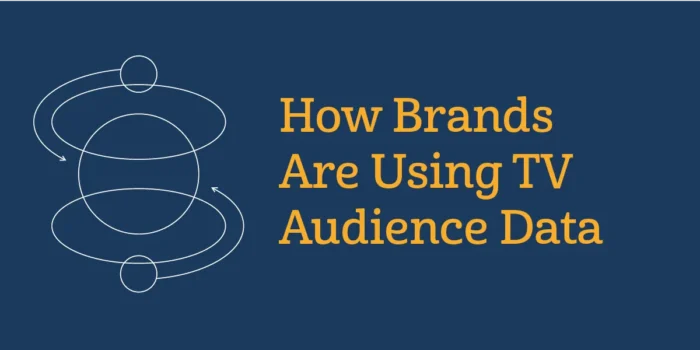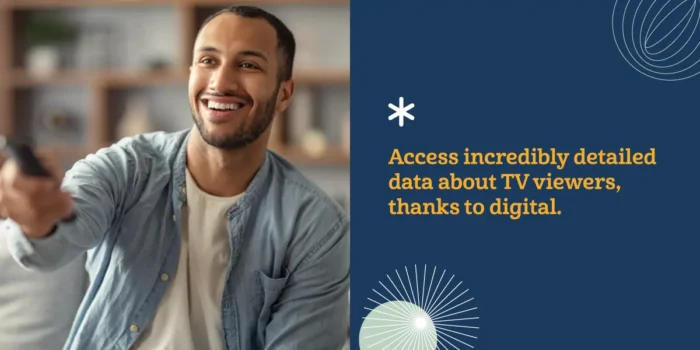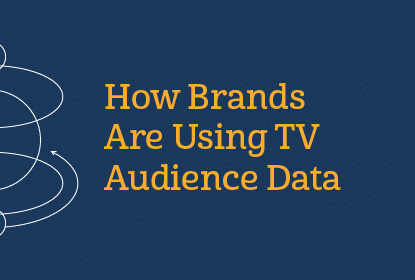
Television isn’t dead, as some might claim, and advertisers should pay attention to it as it evolves significantly. Thanks to the rise of internet-based TV services, we can now watch shows on different devices, including smart TVs, laptops, tablets and smartphones — and even switch back and forth between devices within one viewing session.
But TV isn’t just about entertainment — it holds a treasure trove of valuable insights waiting for us to tap into. Unveiling the power of TV audience data collection and measurement will help you unleash your marketing potential. As traditional TV networks and streaming services continue to evolve, understanding how TV audiences consume content across various devices becomes essential.
In July 2022, streaming services surpassed cable viewing for the first time in the U.S. — accounting for 34.8% of total TV screen time vs. cable and broadcast services accounting for 34.4% and 21.6%, respectively. Not surprisingly, there is a generation gap in TV consumption at play, as the use of streaming services is even higher among young adults.
With this shifting landscape in mind, we’ll dive into the world of Connected TV (CTV), presenting marketers with new opportunities and strategies to make informed decisions through TV audience measurement.
How Is TV Advertising Changing? It’s All About TV + Digital
In the past, advertisers used basic demographic information to target their ads, with age and gender being the main attributes considered. There were also fewer networks and options for devices you could watch. As the TV industry grew and technology evolved, the TV ad landscape became more complex. In this rapidly changing landscape, TV advertising has transcended traditional demographics to embrace the power of TV audience data.

Thanks mainly to the advent of digital technologies, marketers today can access incredibly detailed data about TV viewers. Rather than just basic demographic information such as age and gender, they can now determine in-depth details on viewers’ interests, preferences, purchase habits and location. This data-driven approach enables precise targeting of niche audiences, reducing ad waste and driving better conversions.
This data enables marketers to target increasingly specific TV audiences, leading to higher spending on data and data services by brands. Companies paid $22 billion in 2021 for third-party audience data — showing a continuous increase. Out of that total, $13.3 billion accounted for data itself and $8.7 billion for audience data activation solutions.
Marketers also need to contend with viewers watching content across multiple devices. Over-the-top (OTT) content — or content that viewers access over the internet rather than through a cable or broadcast TV service — continues to gain popularity. Users can watch this advanced TV content on laptops, tablets, smartphones, Connected TVs and even regular TVs turned smart using devices like gaming systems and add-on streaming devices.
While this creates complexity for advertisers, it also provides opportunities for creating more precisely targeted campaigns. Marketers can leverage a people-based ID solution to determine relationships that exist between devices and use this information to target individual users with cohesive, sequential campaigns across all of their devices. This is essential for reaching modern audiences — helping marketers to reach the right individuals at the right times to drive conversions.
With new data technologies and audience-based advertising, marketers can now target their ads to specific user segments with a niche interest or fit a relatively detailed description. This enhanced TV audience targeting leads to less ad waste and more conversions because it helps brands more accurately target users interested in their products or services. This increased precision is possible because of advancements in viewing technology, the increased complexity of the modern viewer’s TV habits and modern data and analytics technologies.
Using TV Audience Data to Plan More Effective Campaigns
To maximize the impact of your marketing campaigns, leveraging TV audience data is essential. By going beyond basic demographic targeting, you can activate TV audiences and amplify across multiple screens, ensuring a cohesive and consistent brand message. Learn strategies for using TV audience data to plan more effective campaigns, from combining first-party and third-party data to connecting with people across multiple devices.
1. Activate TV Audiences and Amplify Across Screens
Marketers today have more data available to them than ever before. Using this data, advertisers can create precise TV data segments to target the exact kinds of users they want to reach with a campaign. You can purchase third-party data, which is data that’s been aggregated from multiple data sources, from third-party data marketplaces such as the Lotame Data Exchange.
Lotame’s Connected TV solutions revolutionize TV advertising by bringing the same level of precision found in digital channels. Activate thousands of third-party audiences on CTV inventory with Lotame’s high quality, identity-powered data. Demo, interest, intent, and CTV viewership (US only) — are targetable on over 50 CTV and OTT media channels globally. Our team can also create custom audiences to match your unique needs. With Lotame, TV + Digital audience activation has never been more accessible or transparent.
By seamlessly activating TV audiences and amplifying across multiple screens, marketers can unleash the true potential of TV advertisement in the digital era.
2. Combine First-Party and Third-Party Data
To thrive in the evolving TV advertising landscape, savvy marketers combine the power of first-party and third-party data. Combining your own first-party data with relevant third-party data can help you to learn more about your audience and improve the results of your campaigns.
Third-party data enables you to find new viewers likely to become customers because they share characteristics with your current audience or customers. It can also help you to determine which ads generate the most sales, app downloads or website visits. These advantages can help marketers to optimize their audience segmentation and campaigns.
By layering on second- and third-party data at scale, you can target ads based on various behavioral, psychographic, demographic and geographic data points such as viewers’ interests, life stage and purchase intent. Combining these multiple attributes enables you to get very specific with your targeting to ensure improved performance across channels.
Lotame’s lookalike modeling capabilities can help you find additional reach to target a small-scale audience. Lotame uses proprietary, powerful machine-learning (ML) algorithms to create look-alike and act-alike audiences based on your data.
The tool analyzes the behavioral attributes of user profiles to determine which characteristics best predict whether a user will take your desired action, whether that’s making a purchase, visiting your website or downloading an app. By focusing on your key performance indicators (KPIs), Lotame’s lookalike modeling capabilities can help you boost the performance of your campaigns using first-party and third-party data.
3. Make Smarter Buying Decisions
In the rapidly evolving landscape of TV advertising, making data-driven decisions is the key to success. With Lotame Analytics at your fingertips, gain valuable and clearer insights into your CTV and digital campaigns. Our robust platform goes beyond surface-level data, offering in-depth insights into viewer behavior, preferences and engagement across TV and digital channels.
Lotame Analytics gives you a 360-degree view of consumers watching your TV shows or commercials. This holistic perspective empowers you to take action with just a click.
Harness the power of TV audience data by tapping into online and offline first-party data or accessing one of the world’s largest global data marketplaces. With this wealth of information, you can generate on-demand, high-definition and binge-worthy TV + Digital audience overlap and index reports.
Ultimately, learning more about your audience and using predictive analytics to assess their behavior enables you to make smarter buying decisions.
By harnessing the wealth of data, you reach more of your target TV audiences, minimize ad waste and significantly improve your campaign ROI. Embrace the potential of TV audience data and elevate your advertising strategy to new heights.
4. Connect With People Across Devices
In the modern era of TV advertising, reaching audiences goes beyond individual devices — it’s about connecting with people seamlessly across screens. Today’s TV and video viewers watch content across multiple screens and can even switch devices in between viewing sessions. They use standard TVs, smartphones, computers, tablets and smart TVs.

This means that to reach viewers effectively, advertisers need to create cohesive messaging across these various screens. To do this, they must understand the connections between devices to determine which ones belong to the same users.
Marketers can create sequential messaging that guides potential customers through the marketing funnel across their various devices by identifying which devices belong to the same users rather than treating each device as a separate customer. This helps viewers to move through your sales funnel more quickly. After all, you want to connect with people, not a device.
Not understanding the connections between devices could also lead to missed opportunities. Here’s a TV audience data example — you might be advertising a new car to someone on their laptop because they searched for new car prices on that device. However, if they pull out their phone to look for local deals on new cars and you don’t know that phone belongs to the same user, you could miss out on serving them an ad when they’re looking for a car dealership to visit. They might find another dealership or a competitor might show them an ad, causing you to potentially lose the lead.
This person-level understanding empowers advertisers to deliver the right message at the right time on the right device, maximizing conversions and fostering stronger connections with viewers. Don’t miss out on valuable opportunities — embrace TV audience data to create impactful cross-device campaigns.
5. Target TV Commercials for Competitive Conquesting
In the ever-evolving landscape of TV advertising, marketers can take their campaigns to new heights through competitive conquesting using TV audience data. In addition to leveraging TV commercials for brand amplification, marketers can use Lotame Data Exchange to target TV commercial viewers by several verticals, including:
- Home improvement
- Banking and payment
- Wireless
- Men’s health
- DIY
- Weight loss
- Baby
- Snack food
- And many more
- Marketers can also request custom-built segments for more refined targeting
Leveraging TV audience data, advertisers can strategically position their commercials to capture the attention of potential customers actively engaged with their competitors. By understanding audience behaviors, preferences and interests, brands can tailor their messages to resonate with viewers and even request custom-built segments for refined targeting.
Competitive conquesting allows marketers to seize valuable opportunities, gaining an edge in the market and driving conversions. It’s a smart and reliable strategy that taps into the power of TV audience data to deliver impactful TV advertisements.
CTV vs. Traditional TV
Two major players are vying for marketers’ attention in TV advertising — CTV and traditional TV. While both mediums allow brands to engage with TV audiences, they differ significantly in their approach and capabilities, especially when utilizing TV audience data.
Traditional TV
Traditional TV has been a long-standing staple in households, delivering content through cable, satellite or broadcast networks. Marketers historically relied on basic demographic data to target their TV advertisements, focusing on age and gender as primary factors. However, with limited data insights, campaigns were often less precise and faced challenges in reaching the right TV audiences.
CTV
Conversely, CTV has revolutionized the advertising landscape, opening doors to a wealth of TV audience data. Viewers can access CTV content through internet-based services on smart TVs, laptops, tablets, smartphones and other connected devices. This digital transformation allows marketers to collect in-depth information about viewers’ interests, preferences, behaviors and purchase habits. By analyzing TV audience data, advertisers can create highly targeted campaigns, reaching specific segments of users who align with their brand’s niche.
TV audience data collection and measurement have become integral to CTV advertising, enabling businesses to understand audience behaviors across devices. Advertisers can leverage this data to create cohesive messaging that follows users seamlessly from one device to another, ensuring a consistent brand experience.
As more companies recognize the potential of CTV, the shift towards data-driven marketing is undoubtedly on the rise, allowing brands to engage with their desired TV audiences.
Find Your CTV Audiences With Lotame’s Connected TV Solutions
Harnessing TV audience data is the key to unlocking the full potential of TV advertising. Lotame, a leading global technology company, offers state-of-the-art Connected TV solutions that empower businesses to find their audiences like never before.
With Lotame’s Connected TV solutions, marketers can scale their impact by engaging customers and prospects on popular CTV platforms like Roku, Apple TV and Amazon Firestick. Whether you’re targeting specific demographics, interests or intent, Lotame provides various audience segments to help you find your ideal TV audience.
With first-party targeting, you can connect with your existing customers across all screens, including CTV, using the Spherical platform. Activate your first-party audiences across major DSPs or create bespoke deal IDs for customized targeting.
For those seeking additional data, Lotame’s high-quality third-party data opens doors to 5,000+ prepackaged audiences, including CTV viewership data in the U.S., targetable on over 50 CTV and OTT media channels globally. The integration with LiveRamp’s Data Marketplace offers instant access to cookieless segments across destinations like Dish, Hulu, Roku and Discovery.
Tap into Lotame’s data expertise for creating custom audiences and consultation on conquering CTV. Marketers can explore sample segments across genres like sports, crime and comedy and interests like DIY, cars and pets.
Get Data Empowered today with one of the largest global footprints of smart TVs, set-top boxes, and gaming consoles available in the market.
Seize Your CTV Spotlight With Lotame’s Connected TV Solutions
In a rapidly evolving TV advertising landscape, harnessing TV audience data is the key to unlocking success. Lotame’s Connected TV solutions offer a powerful arsenal of tools that empower businesses to target TV audiences, engage customers and drive growth precisely. Find your audience effortlessly, from demographics and interests to intent and viewership patterns.
Lotame’s first-party and third-party targeting expertise ensures you reach the right viewers at the right time with custom audiences and high-quality data segments. You can even target individuals who have already seen your competitor’s ads. Instead of paying for competing TV spots, you can target these potential customers across their digital devices with messages that explain why they should choose your product over the competitors. This approach enables you to gain market share while running more efficient campaigns.
To learn more about how we can help you leverage TV audience data to improve your advertising campaigns and strategies, contact us to learn!


